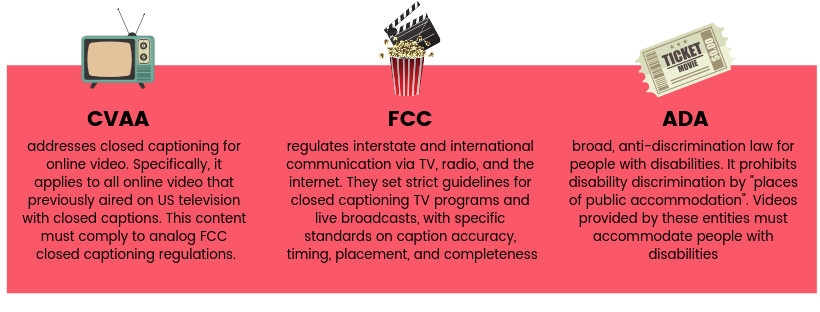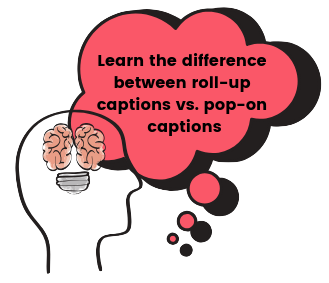How to Meet Captioning Specs for OTT Providers
Updated: July 3, 2019
OTT stands for “over-the-top”. It’s a term used for the way film and TV shows are delivered to the viewer. OTT Providers have swayed away from the traditional cable service, and alternatively deliver content via the internet. Hulu and Netflix are examples of OTT Providers.
Streaming media has completely transformed the face of the entertainment industry. Instead of watching a show or a movie at a designated time and location, people can access online content anytime and anywhere on their mobile and smart devices. With millions of paid subscribers, OTT Providers must appeal to a wide audience, and truly deliver an exceptional viewing experience for everyone.
The rise of OTT Providers and other streaming services has created an influx of online content. Unfortunately, publishers have failed to make all of this content accessible, excluding some people from fully enjoying online video. Deaf and hard of hearing individuals are not able to understand the audio information of a film or TV show without closed captions. There are many accessibility laws including the Twenty-First Century Communications and Video Accessibility Act (CVAA), Federal Communications Commission (FCC), and Americans with Disabilities Act (ADA) that apply to media and entertainment. It’s crucial that OTT Providers makes their content accessible to avoid a potential lawsuit.
If you’re submitting closed caption files to any major OTT providers such as Amazon, Hulu, iTunes, and Netflix, be sure to follow these stringent specifications in order for your file to be accepted.
Amazon Specs
Amazon is a giant in the retail industry; they’ve made their mark in the streaming media industry as well. Their online video service, Prime Video, offers a variety of TV shows and films for users to choose from. Amazon is a customer-centric company, and they make certain that their viewers have a consistent viewing experience, including those who may be deaf or hard of hearing, are non-native English speakers, or are in sound sensitive environments.
Many closed caption formats are accepted by Prime Video:
- SMPTE-TT (RP-2052) with an .xml file extension
- STL (EBU standard) with a .stl file extension (Spruce Subtitle file format which also has an .stl file extension not supported)
- DFXP Full/TTML (Timed Text Markup Language) with a .dfxp file extension
- iTT (iTunes Timed Text) files with a .iTT file extension
- SCC (Scenarist Closed Caption) with a .scc file extension
- SRT (SubRip text file format) with a .srt file extension
The listing language of a title must match the location’s supported language to be able to publish in that location. For instance, captions should be in English for titles published in the U.S. or U.K. The listing language for a title must also be the same as the audio or caption languages.
Amazon recommends that publishers submit pop-on captions (captions that appear one to three lines at a time) for titles. If they are roll-up captions (captions that scroll up the screen one line at a time), they must be converted to pop-on in order to be accepted. Keep in mind, when converting captions from roll-up to pop-on, this adds opportunity for error.
Some titles may not have dialogue or may go through an extended period of time without dialogue. In instances where there is no dialogue, captions should include a description of the foreground or background audio elements or caption. If there is no audio, captions should read “[no audio]”. Music lyrics should be captioned verbatim.
All timed-text assets must start with zero-hour code (i.e. 00:00:00). If your captions don’t adhere to this, they won’t display at the right time. Timed-text assets need to be UTF-8 encoded, since Prime Video doesn’t support anything else.
Amazon is one of the many OTT Providers that highly recommends hiring a third party captioning company for captioning services. Their main priority is creating an enjoyable experience for all customers. High-quality, accurate captions ensure that this is possible.
Hulu Specs
Hulu provides closed captions for videos played on their streaming service. However, there are currently no specifications available to the public. 3Play has strict closed captioning standards you can use for digital distribution of TV and film. In order to meet FCC standards for media broadcasting, these factors must be considered during the captioning process:
You can also refer to our caption frame display standards. These standards are designed for optimal reader comprehension.
- Best to use a non-serif font style (i.e. Helvetica medium) for caption text
- Each caption frame should hold one to three lines of text at a time and each line shouldn’t exceed 32 characters
- The minimum duration of a caption frame is 1 second. All caption frames should be time-synced to the audio
- Caption frames should be repositioned if they obscure onscreen text
iTunes Specs
Did you know a high percentage of closed caption deliveries to iTunes are rejected due to closed captioning problems? If you’re submitting a video file with captions to iTunes, be sure to learn from these common problems that arise in closed caption deliveries, and how you can avoid these same problems when submitting your own file. This OTT Provider’s specs are used to confirm synchronicity, as opposed to verifying display position or size of closed captions.
Many closed caption deliveries are rejected due to synchronicity problems that usually fall into two categories:
- Closed captioning is out of sync for the entire movie: this means the audio either precedes or lags behind the closed caption text. This is usually caused by repurposing a .scc file from a DVD.
- Closed captioning begins in sync, but becomes out of sync by the end of the movie: either the closed caption drifts out of sync over the course of the movie, or the file is in sync for the first part of the movie and is not for the remaining part of the movie. This occurs with longer files, usually longer than 90 minutes.
To avoid these problems with your own file, it’s recommended to hire a captioning company in order to ensure all caption files are synchronous with the audio.
Netflix Specs
Netflix is one the biggest entertainment providers, with over 137 million subscribers. The streaming media giant was sued in June 2011 by the National Association of the Deaf (NAD) for failing to provide closed captioning for streaming video, thus violating the Americans with Disabilities Act (ADA). As a result, Netflix began captioning their titles with strict standards for closed captions.
Any timed-text for original Netflix shows or non-original shows must follow the Netflix Style Guide in order to be accepted. Closed captions are viewed as a primary asset instead of a secondary asset for OTT Providers, therefore these standards are continuously refined to ensure high quality captions.
All caption files submitted to Netflix must be delivered in a TTML (.dfxp or .xml) format.
- Character limitation: 42 characters per line
- Font: arial as a generic placeholder for proportional san serif
- Font color: white
- Reading speed: 20 characters per second for adult programs and 17 characters per second for children’s programs
- Speaker ID/sound effects: only use speaker IDs or sound effects when they cannot be visually identified
- Special instructions: plot-pertinent dialogue always takes precedence over background dialogue
__________________________________________________
Further Reading

Subscribe to the Blog Digest
Sign up to receive our blog digest and other information on this topic. You can unsubscribe anytime.
By subscribing you agree to our privacy policy.










